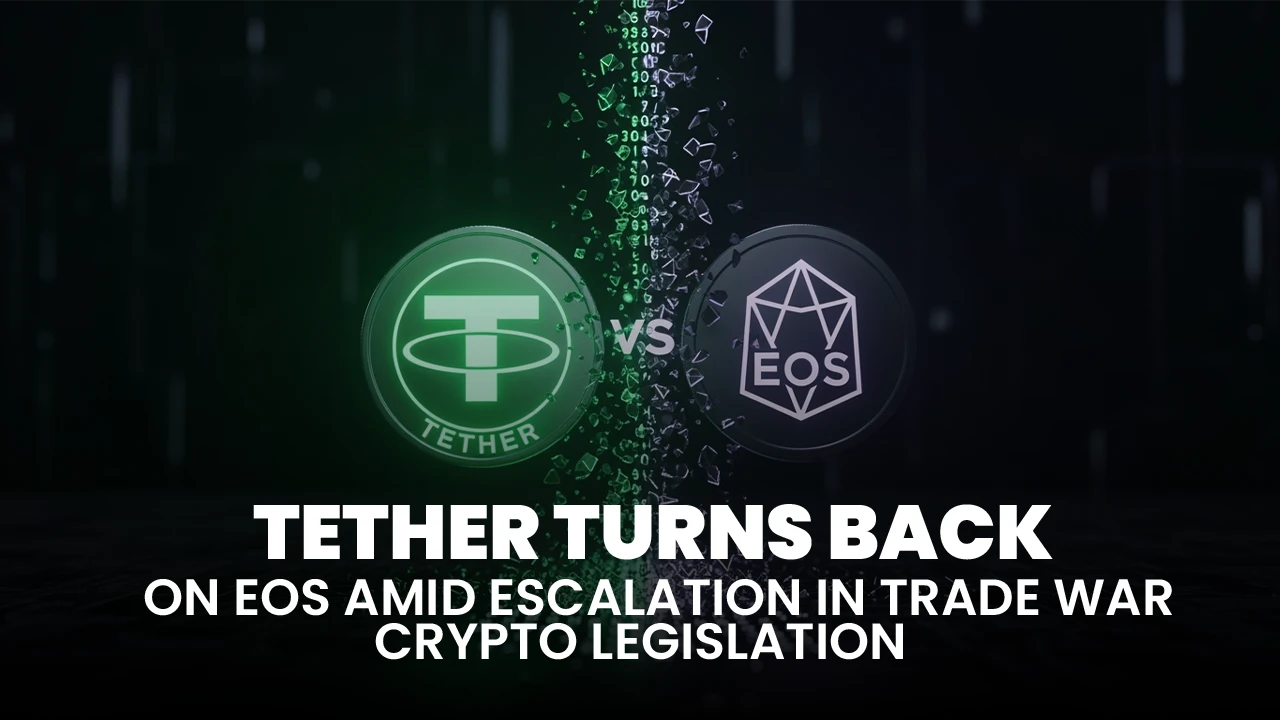Tether Turns its Back on EOS Amid Escalation in Trade War, Crypto Legislation

Tether’s exit from EOS and similar blockchains reflects a shift in priorities amid increasing global economic pressures and regulatory debate in the U.S.
Tether, the company behind the widely used USDT stablecoin, has confirmed it will no longer support five of the networks it currently issues USDT. The platforms being dropped are EOS, Omni, Bitcoin Cash SLP, Algorand, and Kusama.
Starting August 17, Tether will stop minting new USDT tokens on these networks. Users will still be able to redeem or swap existing tokens for at least 12 months, allowing for a smoother transition.
This move reflects Tether’s decision to concentrate resources on blockchain ecosystems that are more scalable, cost-effective, and actively used by developers and institutions.
Decline in EOS Activity and the Role of DPoS
EOS once stood out as a top contender in the blockchain world. Its performance was driven by the Delegated Proof-of-Stake (DPoS) consensus mechanism, which enabled faster transactions by allowing a small group of validators to maintain the network. This design made EOS highly efficient and attractive for decentralized applications.
However, technical innovation alone was insufficient to sustain long-term growth. Over time, developer activity on EOS declined, user adoption dropped, and enthusiasm from the broader crypto community faded. While DPoS provided scalability, the network struggled with concerns over centralization, governance challenges, and limited expansion in the DeFi space.
ALSO READ: Cardano Foundation Ups the Spending Ante by 15% in a Year: What It Means for Blockchain’s Future
Tether’s decision to withdraw USDT support from EOS reflects these broader issues. The company is redirecting its efforts to ecosystems with proven demand, stronger communities, and scalable infrastructure that aligns with evolving market needs.
Regulatory and Trade Tensions Weigh on Crypto
Tether’s decision comes at a time when lawmakers in the United States are actively debating how to regulate digital assets, including stablecoins like USDT. Proposed legislation, such as the Financial Innovation and Technology for the 21st Century Act, has sparked strong disagreement among policymakers. Some argue the bills could give Wall Street an unfair advantage, while others claim they are necessary to provide legal clarity for the industry.
These debates are unfolding against a backdrop of renewed global trade tensions. The U.S. has issued warnings about potential tariffs on goods from Mexico and the European Union, raising fears of economic instability.
In this complex environment, Tether appears to be doubling down on platforms that can support regulatory compliance and offer consistent performance. Networks that fail to evolve or show measurable progress, like EOS, are being left behind.
EOS Loses Key Support
The withdrawal of Tether support is a serious blow for EOS. Once positioned as a high-performance alternative to Ethereum, EOS now faces dwindling relevance. The loss of USDT issuance could further shrink its role in decentralized finance, where stablecoins are essential for liquidity, trading, and ecosystem stability.
Despite its technical foundation, EOS has not kept pace with rising competitors that offer stronger incentives, faster innovation, and better alignment with institutional needs, without active support from key players like Tether, the network risks sliding further out of view.
Conclusion
Tether’s move to discontinue USDT issuance on EOS and four other blockchains marks a turning point for the stablecoin landscape. The focus is shifting toward networks that combine scalability, real-world utility, and compliance-readiness.
EOS, though once promising with its DPoS architecture, has been unable to sustain long-term momentum. As the digital asset space matures, projects that fail to keep pace with market expectations and policy shifts may continue to lose ground. Tether’s latest decision is a clear signal of where the industry is heading.
FAQs
Q1: Which blockchains will Tether stop supporting?
Tether will end USDT issuance on EOS, Omni, Bitcoin Cash SLP, Algorand, and Kusama.
Q2: What is the timeline for this change?
New USDT will no longer be issued on these networks after August 17. Redemptions will remain available for at least 12 months.
Q3: Why is EOS being phased out?
EOS has seen reduced activity, falling developer interest, and limited ecosystem growth, despite its DPoS-based scalability.
Q4: How are politics influencing Tether’s decision?
While not explicitly cited, the announcement comes amid intense U.S. legislative debates on stablecoins and growing international trade tensions.
Q5: What networks is Tether focusing on instead?
Tether is prioritizing platforms with higher adoption and scalability, including Ethereum Layer 2 solutions and other high-performance blockchains.
Glossary of Key Terms
Tether (USDT): A stablecoin pegged to the U.S. dollar, commonly used for trading and transferring value in the crypto ecosystem.
EOS: A blockchain platform using Delegated Proof-of-Stake (DPoS) that once aimed to compete with Ethereum in scalability and speed.
DPoS (Delegated Proof-of-Stake): A blockchain consensus mechanism that improves efficiency by allowing a limited number of validators to confirm transactions.
Layer 2: Technologies that enhance the performance of base-layer blockchains by enabling faster and cheaper transactions.
Stablecoin: A type of cryptocurrency designed to maintain a stable value, usually pegged to a fiat currency like the U.S. dollar.




